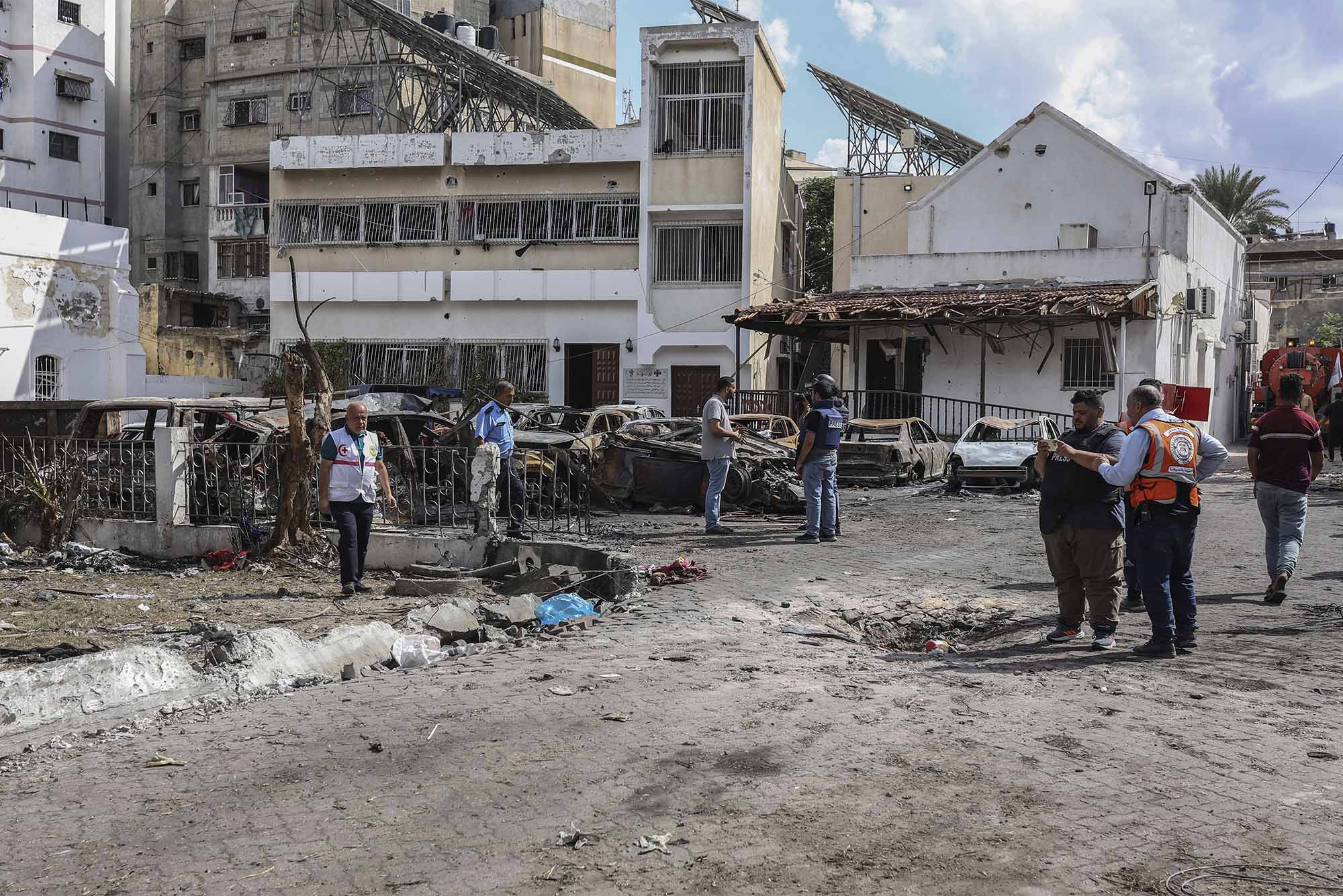Misinformation, Disinformation, and the Israel-Hamas War

Palestinians inspecting the destruction following an attack on the Al Ahli Arab Hospital in Gaza, which killed dozens of civilians. In the aftermath of the attack, many news outlets were forced to apologize after initially reporting Hamas’ unverified claims that Israel was to blame. Photo by Mohammad Abu Elsebah/picture-alliance/dpa/AP Images
Misinformation and Disinformation—What They Mean for the Israel-Hamas War
Bad information of any kind, intentional or accidental, leads to a “polluted information environment” that can make it hard to tell what’s real and what’s not, says BU’s Lee McIntyre
Editor’s note, October 25: This story was updated with new information about the hospital explosion.
In the weeks since Hamas militants stormed Israel, videos, images, and firsthand accounts of attacks and counterattacks have flooded social media platforms, giving people around the world direct insight into the war. The problem, however, is that not all of it is true.
And when accounts filled with falsehoods mix with the truth, they “pollute the entire information ecosystem,” making it harder for everyone to tell fact from fiction, says Lee McIntyre, a research fellow at Boston University’s Center for Philosophy & History of Science.
“One of the dangers here is that disinformation doesn’t just get you to believe a false thing is true; it also gets you to believe a true thing is false. That’s the poison that disinformation puts in the atmosphere,” McIntyre says.
There’s an important distinction between the words disinformation and misinformation, he says: disinformation is an intentional falsehood, whereas misinformation is an accident.
“Misinformation is when someone shares a falsehood, believing it to be true. Maybe they’ve been duped by someone else, but it’s information they think is true that they pass along,” he says. “Disinformation, on the other hand, is an intentional falsehood that someone created and shared in hopes of deceiving other people, for a purpose.”
Both can be—and often are—at play during especially fraught global events, such as a presidential election or an emerging war. But, McIntyre says, disinformation in particular leaves insidious damage in its wake: “One thing that disinformation does is it erodes not only your knowledge base, but your trust in other people to tell you the truth, because sometimes disinformation comes in a neat little package of a conspiracy theory.”
In this polluted information environment, truth and falsehoods exist side-by-side, and it can be difficult for even usually trustworthy sources to discern what’s what. Take, for example, the destruction at the Al Ahli Arab Hospital in Gaza, on October 17. Almost immediately after the blast, which killed hundreds, Hamas blamed Israel for the explosion. News outlets in the United States and elsewhere initially reported that the explosion was caused by an Israeli airstrike, only to backtrack when more evidence emerged suggesting the damage was not consistent with a standard Israeli airstrike. President Biden later supported Israel’s assertion that the explosion was caused by a failed rocket from an armed Palestinian group, but further analysis by the New York Times and Al-Jazeera of video evidence presented by Israeli forces refutes Israel’s claim. As of this writing, neither news outlet has reported definitively who is responsible for the blast, and the United Nations has called for an independent international investigation into the explosion.
I personally think the most dangerous part of disinformation is the way it can make us cynical, because it plays right into the authoritarians’ hands.
In this case, determining who is to blame for the explosion has real, and global, humanitarian consequences, and it takes time to sift through evidence and determine what’s real and what’s not. But in a society where millions of people can access a firehose of unvetted information in the palm of their hands, McIntyre says, bad actors take advantage of this confusing and convoluted influx of information to move public opinion.
“I personally think the most dangerous part of disinformation is the way it can make us cynical, because it plays right into the authoritarians’ hands. Authoritarians love to use disinformation—maybe they can convince you [to believe their narrative], but even if they can’t convince you, they can demoralize you and make you feel like there’s no use even fighting back,” he says.
Writing in Time magazine, BU’s Joan Donovan, a renowned expert in online misinformation and disinformation campaigns, says that the torrent of “true horror, violent pronunciations, sadness, and disinformation” online when talking about Hamas and Israel on social media is more than the “fog of war.” A College of Communication assistant professor, Donovan writes that “we are involved in an information war playing out across all social media platforms every day,” often as unwitting participants who share what may be dubious posts.
Disinformation is everywhere, and thanks to artificial intelligence–powered tools, it’s easier to make than ever, McIntyre says, but he urges people not to lose hope. His new book, On Disinformation: How to Fight for Truth and Protect Democracy (MIT Press, 2023), outlines straightforward ways people can sift through information to determine what’s real.
He advises people to look for reliable sources, and understand that even they may have biases, in addition to taking a more active role by, for example, pushing Congress to better regulate information on social media platforms.
“This is a depressing topic, and I get that,” he says. “But it is also something that we can learn to fight back against. And the primary way to fight back is to expose [something as] disinformation. As I often say, ‘You cannot win a disinformation war unless you realize you’re in one.’”

Comments & Discussion
Boston University moderates comments to facilitate an informed, substantive, civil conversation. Abusive, profane, self-promotional, misleading, incoherent or off-topic comments will be rejected. Moderators are staffed during regular business hours (EST) and can only accept comments written in English. Statistics or facts must include a citation or a link to the citation.